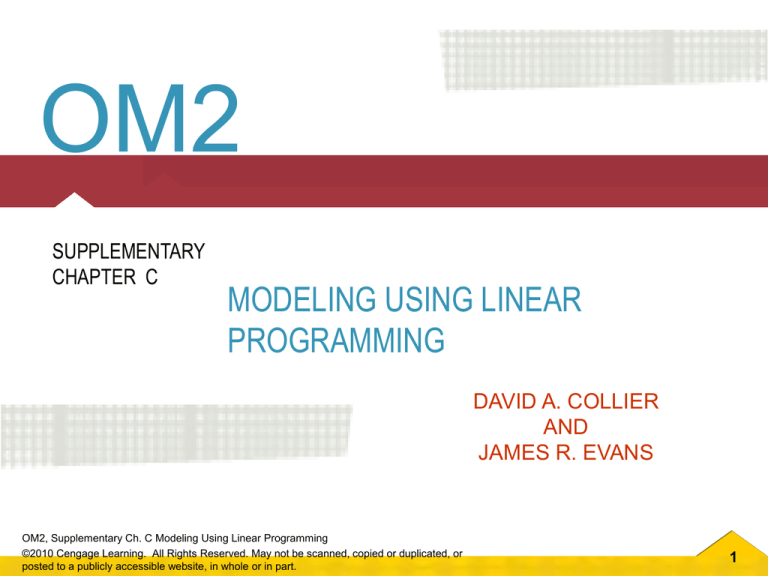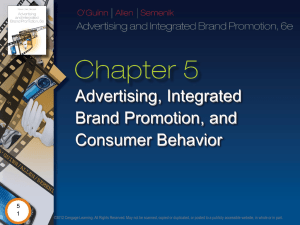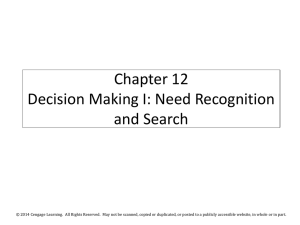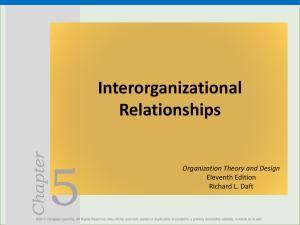
OM2
SUPPLEMENTARY
CHAPTER C
MODELING USING LINEAR
PROGRAMMING
DAVID A. COLLIER
AND
JAMES R. EVANS
OM2, Supplementary Ch. C Modeling Using Linear Programming
©2010 Cengage Learning. All Rights Reserved. May not be scanned, copied or duplicated, or
posted to a publicly accessible website, in whole or in part.
1
Supplementary Chapter C. Modeling Using Linear Programming
learning outcomes
LO1 Explain how to recognize decision variables, the
LO2
LO3
objective function, and constraints in formulating
linear optimization models.
Describe how to use linear optimization models for
OM applications.
Explain how to use Excel Solver to solve linear
optimization models on spreadsheets.
OM2, Supplementary Ch. C Modeling Using Linear Programming
©2010 Cengage Learning. All Rights Reserved. May not be scanned, copied or duplicated, or
posted to a publicly accessible website, in whole or in part.
2
Supplementary Chapter C. Modeling Using Linear Programming
h
aller’s Pub & Brewery is a small restaurant and
microbrewery that makes six types of special
beers, each having a unique taste and color. Jeremy
Haller, one of the family owners who oversees the
brewery operations, has become worried about
increasing costs of grains and hops that are the
principal ingredients and the difficulty they seem to
be having in making the right product mix to meet
demand and using the ingredients that are
purchased under contract in the commodities
market. Haller’s buys six different types of grains
and four different types of hops.
OM2, Supplementary Ch. C Modeling Using Linear Programming
©2010 Cengage Learning. All Rights Reserved. May not be scanned, copied or duplicated, or
posted to a publicly accessible website, in whole or in part.
3
Supplementary Chapter C. Modeling Using Linear Programming
Each of the beers needs different amounts of
brewing time and is produced in 30-keg (4,350-pint)
batches. While the average customer demand is 55
kegs per week, the demand varies by type. In a
meeting with the other owners, Jeremy stated that
Haller’s has not been able to plan effectively to meet
the expected demand. “I know there must be a
better way of making our brewing decisions to
improve our profitability.”
OM2, Supplementary Ch. C Modeling Using Linear Programming
©2010 Cengage Learning. All Rights Reserved. May not be scanned, copied or duplicated, or
posted to a publicly accessible website, in whole or in part.
4
Supplementary Chapter C. Modeling Using Linear Programming
What do you think?
Can you identify any examples when you
needed to find a better way of planning,
designing, or operating some system or
process?
OM2, Supplementary Ch. C Modeling Using Linear Programming
©2010 Cengage Learning. All Rights Reserved. May not be scanned, copied or duplicated, or
posted to a publicly accessible website, in whole or in part.
5
Supplementary Chapter C. Modeling Using Linear Programming
Quantitative models that seek to maximize or
minimize some objective function while satisfying a
set of constraints are called optimization models.
Linear programming (LP) models are used
widely for many types of operations design and
planning problems that involve allocating limited
resources among competing alternatives, and for
supply chain management design and operations.
OM2, Supplementary Ch. C Modeling Using Linear Programming
©2010 Cengage Learning. All Rights Reserved. May not be scanned, copied or duplicated, or
posted to a publicly accessible website, in whole or in part.
6
Supplementary Chapter C. Modeling Using Linear Programming
Softwater Production Planning Problem
• Pellets are produced in 40- and 80-pound
bags.
• Company has orders for 20,000 pounds
• 4,000 pounds are currently in inventory
• Limited amounts of packaging materials
and packaging line time
• Determine how many bags of each size to
produce to maximize profit.
OM2, Supplementary Ch. C Modeling Using Linear Programming
©2010 Cengage Learning. All Rights Reserved. May not be scanned, copied or duplicated, or
posted to a publicly accessible website, in whole or in part.
7
Supplementary Chapter C. Modeling Using Linear Programming
Decision Variables
A decision variable is a controllable input
variable that represents the key decisions
a manager must make to achieve an
objective.
x1 = number of 40-pound bags produced
x2 = number of 80-pound bags produced
OM2, Supplementary Ch. C Modeling Using Linear Programming
©2010 Cengage Learning. All Rights Reserved. May not be scanned, copied or duplicated, or
posted to a publicly accessible website, in whole or in part.
8
Supplementary Chapter C. Modeling Using Linear Programming
Objective Function
Suppose that Softwater makes $2 for every 40-lb.
bag and $4 for every 80-lb. bag produced and
sold.
Max total profit = z = 2x1 + 4x2
[C.1]
The constant terms in the objective function are
called objective function coefficients.
OM2, Supplementary Ch. C Modeling Using Linear Programming
©2010 Cengage Learning. All Rights Reserved. May not be scanned, copied or duplicated, or
posted to a publicly accessible website, in whole or in part.
9
Supplementary Chapter C. Modeling Using Linear Programming
Solutions
Any particular combination of decision
variables is referred to as a solution.
Solutions that satisfy all constraints are
referred to as feasible solutions.
Any feasible solution that optimizes the
objective function is called an optimal
solution.
OM2, Supplementary Ch. C Modeling Using Linear Programming
©2010 Cengage Learning. All Rights Reserved. May not be scanned, copied or duplicated, or
posted to a publicly accessible website, in whole or in part.
10
Supplementary Chapter C. Modeling Using Linear Programming
A Solution for the Softwater Problem
Suppose that Softwater decided to
produce 200 40-pound bags and 300 80pound bags. The profit would be
z = 2(200) + 4(300)
= 400 + 1,200
= $1,600
OM2, Supplementary Ch. C Modeling Using Linear Programming
©2010 Cengage Learning. All Rights Reserved. May not be scanned, copied or duplicated, or
posted to a publicly accessible website, in whole or in part.
11
Supplementary Chapter C. Modeling Using Linear Programming
Constraints
A constraint is some limitation or requirement
that must be satisfied by the solution.
Suppose that each 40-pound bag requires 1.2
minutes of packaging time per bag and 80pound bags require 3 minutes per bag. The total
packaging time required is
1.2x1 + 3x2
Only 1,500 minutes of packaging time are
available, so we have the constraint:
1.2x1 + 3x2 ≤ 1,500
OM2, Supplementary Ch. C Modeling Using Linear Programming
©2010 Cengage Learning. All Rights Reserved. May not be scanned, copied or duplicated, or
posted to a publicly accessible website, in whole or in part.
12
Supplementary Chapter C. Modeling Using Linear Programming
Packaging Material Constraint
Softwater has 6,000 square feet of
packaging materials available; each 40pound bag requires 6 square feet and
each 80-pound bag requires 10 square
feet. Since the amount of packaging
materials used cannot exceed what is
available, we have the constraint:
6x1 + 10x2 ≤ 6,000
OM2, Supplementary Ch. C Modeling Using Linear Programming
©2010 Cengage Learning. All Rights Reserved. May not be scanned, copied or duplicated, or
posted to a publicly accessible website, in whole or in part.
13
Supplementary Chapter C. Modeling Using Linear Programming
Aggregate Production Constraint
We need to produce a net amount of 16,000
pounds. Because the small bags contain 40
pounds of pellets and the large bags
contain 80 pounds, we must impose this
aggregate-demand constraint:
40x1 + 80x2 ≥ 16,000
OM2, Supplementary Ch. C Modeling Using Linear Programming
©2010 Cengage Learning. All Rights Reserved. May not be scanned, copied or duplicated, or
posted to a publicly accessible website, in whole or in part.
14
Supplementary Chapter C. Modeling Using Linear Programming
Nonnegativity Constraints
We must prevent the decision variables from
having negative values. Thus, we need the
constraints:
x1 and x2 ≥ 0
OM2, Supplementary Ch. C Modeling Using Linear Programming
©2010 Cengage Learning. All Rights Reserved. May not be scanned, copied or duplicated, or
posted to a publicly accessible website, in whole or in part.
15
Supplementary Chapter C. Modeling Using Linear Programming
Softwater Optimization Model
Max z = 2x1 + 4x2 (profit)
subject to
1.2x1 + 3x2 ≤ 1,500 (packaging line)
6x1 + 10x2 ≤ 6,000 (materials
availability)
40x1 + 80x2 ≥16,000 (aggregate
production)
x1, x2 ≥ 0 (nonnegativity)
OM2, Supplementary Ch. C Modeling Using Linear Programming
©2010 Cengage Learning. All Rights Reserved. May not be scanned, copied or duplicated, or
posted to a publicly accessible website, in whole or in part.
16
Supplementary Chapter C. Modeling Using Linear Programming
Linear Functions
A function in which each variable appears in a
separate term and is raised to the first power
is called a linear function.
The objective function and all constraints of
the Softwater problem consist of linear
functions. This is a requirement for a linear
program and its solution procedure.
OM2, Supplementary Ch. C Modeling Using Linear Programming
©2010 Cengage Learning. All Rights Reserved. May not be scanned, copied or duplicated, or
posted to a publicly accessible website, in whole or in part.
17
Supplementary Chapter C. Modeling Using Linear Programming
Production Scheduling
Bollinger Electronics Company produces two
electronic components for an airplane
engine manufacturer. Demand for the next
three months is:
OM2, Supplementary Ch. C Modeling Using Linear Programming
©2010 Cengage Learning. All Rights Reserved. May not be scanned, copied or duplicated, or
posted to a publicly accessible website, in whole or in part.
18
Supplementary Chapter C. Modeling Using Linear Programming
Decision Variables
xim denotes the production volume in units for
product i in month m. Here i =1, 2, and m
= 1, 2, 3; i = 1 refers to component 322A,
i = 2 to component 802B, m = 1 to April,
m = 2 to May, and m = 3 to June.
OM2, Supplementary Ch. C Modeling Using Linear Programming
©2010 Cengage Learning. All Rights Reserved. May not be scanned, copied or duplicated, or
posted to a publicly accessible website, in whole or in part.
19
Supplementary Chapter C. Modeling Using Linear Programming
Objective Function
Component 322A costs $20 per unit to
produce and component 802B costs $10
per unit to produce. The production-cost
part of the objective function is:
20x11 + 20x12 + 20x13 + 10x21 + 10x22 + 10x23
OM2, Supplementary Ch. C Modeling Using Linear Programming
©2010 Cengage Learning. All Rights Reserved. May not be scanned, copied or duplicated, or
posted to a publicly accessible website, in whole or in part.
20
Supplementary Chapter C. Modeling Using Linear Programming
Objective Function
To incorporate the relevant inventory costs into the
model, let Iim denote the inventory level for
product i at the end of month m. Inventoryholding costs are 1.5 percent of the cost of the
product; that is, (.015)($20) = $0.30 per unit for
component 322A, and (.015)($10) = $0.15 per
unit for component 802B. The inventory-holding
cost portion of the objective function can be
written as:
0.30I11 + 0.30I12 + 0.30I13 + 0.15I21 + 0.15I22 + 0.15I23
OM2, Supplementary Ch. C Modeling Using Linear Programming
©2010 Cengage Learning. All Rights Reserved. May not be scanned, copied or duplicated, or
posted to a publicly accessible website, in whole or in part.
21
Supplementary Chapter C. Modeling Using Linear Programming
Objective Function
To incorporate the costs due to fluctuations in
production levels from month to month, we need to
define additional decision variables:
Rm = increase in the total production level during month
m compared with month m – 1
Dm = decrease in the total production level during
month m compared with month m – 1
OM2, Supplementary Ch. C Modeling Using Linear Programming
©2010 Cengage Learning. All Rights Reserved. May not be scanned, copied or duplicated, or
posted to a publicly accessible website, in whole or in part.
22
Supplementary Chapter C. Modeling Using Linear Programming
Complete Objective Function
Min 20x11 + 20x12 + 20x13 + 10x21 + 10x22 + 10x23 +
0.30I11 + 0.30I12 + 0.30I13 + 0.15I21 + 0.15I22 + 0.15I23
+ 0.50R1 + 0.50R2 + 0.50R3 + 0.20D1 + 0.20D2 + 0.20D3
OM2, Supplementary Ch. C Modeling Using Linear Programming
©2010 Cengage Learning. All Rights Reserved. May not be scanned, copied or duplicated, or
posted to a publicly accessible website, in whole or in part.
23
Supplementary Chapter C. Modeling Using Linear Programming
Constraints
First we must guarantee that the schedule meets
customer demand. We have the basic equation:
Ending inventory from previous month +
Current production – Ending inventory for
this month = This month’s demand
Assume inventories at the beginning of the threemonth scheduling period are 500 units for
component 322A and 200 units for component
802B.
OM2, Supplementary Ch. C Modeling Using Linear Programming
©2010 Cengage Learning. All Rights Reserved. May not be scanned, copied or duplicated, or
posted to a publicly accessible website, in whole or in part.
24
Supplementary Chapter C. Modeling Using Linear Programming
Constraints
Month 1: 500 + x11 – I11 = 1000
200 + x21 – I21 = 1000
Month 2: I11 + x12 – I12 = 3,000
I21 + x22 – I22 = 500
Month 3: I12 + x13 – I13 = 5,000
I22 + x23 – I23 = 3,000
OM2, Supplementary Ch. C Modeling Using Linear Programming
©2010 Cengage Learning. All Rights Reserved. May not be scanned, copied or duplicated, or
posted to a publicly accessible website, in whole or in part.
25
Supplementary Chapter C. Modeling Using Linear Programming
Constraints
Minimum Inventory Level:
At least 400 units of component 322A and at
least 200 units of component 802B:
I13 ≥ 400 and I23 ≥ 200
OM2, Supplementary Ch. C Modeling Using Linear Programming
©2010 Cengage Learning. All Rights Reserved. May not be scanned, copied or duplicated, or
posted to a publicly accessible website, in whole or in part.
26
Exhibits C.1 and C.2
Additional Constraint Data
Additional Constraint Data
OM2, Supplementary Ch. C Modeling Using Linear Programming
©2010 Cengage Learning. All Rights Reserved. May not be scanned, copied or duplicated, or
posted to a publicly accessible website, in whole or in part.
27
Supplementary Chapter C. Modeling Using Linear Programming
Constraints
Machine capacity:
0.10x11 + 0.08x21 ≤ 400 (month 1)
Labor capacity:
0.05x11 + 0.07x21 ≤ 300 (month 1)
Storage capacity:
2I11 + 3I21 ≤ 10,000 (month 1)
0.10x12 + 0.08x22 ≤ 500 (month 2)
0.10x13 +1 0.08x23 ≤ 600 (month 3)
0.05x12 + 0.07x22 ≤ 300 (month 2)
0.05x13 + 0.07x23 ≤ 300 (month 3)
2I12 + 3I22 ≤ 10,000 (month 2)
2I13 + 3I23 ≤ 10,000 (month 3)
OM2, Supplementary Ch. C Modeling Using Linear Programming
©2010 Cengage Learning. All Rights Reserved. May not be scanned, copied or duplicated, or
posted to a publicly accessible website, in whole or in part.
28
Supplementary Chapter C. Modeling Using Linear Programming
Constraints
We must also guarantee that Rm and Dm will reflect
the increase or decrease in the total production
level for month m. Suppose the production levels
for March were 1,500 units of component 322A
and 1,000 units of component 802B. Then
April production – March production = Change
x11 + x21 – 2,500 = Change
x11 + x21 – 2,500 = R1 – D1
Similar constraints for May and June.
OM2, Supplementary Ch. C Modeling Using Linear Programming
©2010 Cengage Learning. All Rights Reserved. May not be scanned, copied or duplicated, or
posted to a publicly accessible website, in whole or in part.
29
Supplementary Chapter C. Modeling Using Linear Programming
Constraints
Production Smoothing Constraints:
x11 + x21
– R1 + D1 = 2,500
– x11 – x21 + x12 + x22 – R2 + D2 = 0
– x12 – x22 + x13 + x23 – R3 + D3 = 0
OM2, Supplementary Ch. C Modeling Using Linear Programming
©2010 Cengage Learning. All Rights Reserved. May not be scanned, copied or duplicated, or
posted to a publicly accessible website, in whole or in part.
30
Supplementary Chapter C. Modeling Using Linear Programming
Blending Problems
Grand Strand Oil Company produces regulargrade and premium-grade gasoline
products by blending three petroleum
components. The gasolines are sold at
different prices, and the petroleum
components have different costs. The firm
wants to determine how to blend the three
components into the two products in such
a way as to maximize profits.
OM2, Supplementary Ch. C Modeling Using Linear Programming
©2010 Cengage Learning. All Rights Reserved. May not be scanned, copied or duplicated, or
posted to a publicly accessible website, in whole or in part.
31
Exhibit C.4
Petroleum Component Cost and Supply
Data
Regular-grade gasoline can be sold for $2.20 per gallon and
the premium-grade gasoline for $2.40 per gallon. Current
commitments to distributors require Grand Strand to
produce at least 10,000 gallons of regular-grade gasoline.
OM2, Supplementary Ch. C Modeling Using Linear Programming
©2010 Cengage Learning. All Rights Reserved. May not be scanned, copied or duplicated, or
posted to a publicly accessible website, in whole or in part.
32
Exhibit C.5
Component Specifications for Grand Strand’s Products
Data
OM2, Supplementary Ch. C Modeling Using Linear Programming
©2010 Cengage Learning. All Rights Reserved. May not be scanned, copied or duplicated, or
posted to a publicly accessible website, in whole or in part.
33
Supplementary Chapter C Modeling Using Linear Programming
Decision Variables
x1r = gallons of component 1 in regular gasoline
x2r = gallons of component 2 in regular gasoline
x3r = gallons of component 3 in regular gasoline
x1p = gallons of component 1 in premium gasoline
x2p = gallons of component 2 in premium gasoline
x3p = gallons of component 3 in premium gasoline
OM2, Supplementary Ch. C Modeling Using Linear Programming
©2010 Cengage Learning. All Rights Reserved. May not be scanned, copied or duplicated, or
posted to a publicly accessible website, in whole or in part.
34
Supplementary Chapter C. Modeling Using Linear Programming
Objective Function
Max 2.20(x1r + x2r + x3r) + 2.40(x1p + x2p + x3p) –
1.00(x1r + x1p) - 1.20(x2r + x2p) - 1.64(x3r + x3p)
By combining terms, we can then write the
objective function as:
Max 1.20x1r + 1.00x2r + 0.56x3r + 1.40x1p +
1.20x2p + 0.76x3p
OM2, Supplementary Ch. C Modeling Using Linear Programming
©2010 Cengage Learning. All Rights Reserved. May not be scanned, copied or duplicated, or
posted to a publicly accessible website, in whole or in part.
35
Supplementary Chapter C. Modeling Using Linear Programming
Constraints
Component availability:
x1r + x1p ≤ 5,000 (component 1)
x2r + x2p ≤ 10,000 (component 2)
x3r + x3p ≤ 10,000 (component 3)
Regular grade gasoline requirement:
x1r + x2r +x3r ≥ 10,000
OM2, Supplementary Ch. C Modeling Using Linear Programming
©2010 Cengage Learning. All Rights Reserved. May not be scanned, copied or duplicated, or
posted to a publicly accessible website, in whole or in part.
36
Supplementary Chapter C. Modeling Using Linear Programming
Constraints
Component 1 must account for at most 30 percent of
the total gallons of regular gasoline produced:
x1r /(x1r + x2r + x3r) ≤ 0.30 or x1r ≤ 0.30(x1r + x2r + x3r)
Rewrite this as:
0.70x1r - 0.30x2r - 0.30x3r ≤ 0
Other specification constraints:
– 0.40x1r + 0.60x2r – 0.40x3r ≤0
– 0.20x1r – 0.20x2r + 0.80x3r ≤ 0
– 0.75x1p – 0.25x2p – 0.25x3p ≤ 0
– 0.40x1p + 0.60x2p – 0.40x3p ≤ 0
– 0.30x1p – 0.30x2p + 0.70x3p ≤ 0
OM2, Supplementary Ch. C Modeling Using Linear Programming
©2010 Cengage Learning. All Rights Reserved. May not be scanned, copied or duplicated, or
posted to a publicly accessible website, in whole or in part.
37
Supplementary Chapter C. Modeling Using Linear Programming
Transportation Problem
The transportation problem is a special
type of linear program that arises in
planning the distribution of goods and
services from several supply points to
several demand locations.
OM2, Supplementary Ch. C Modeling Using Linear Programming
©2010 Cengage Learning. All Rights Reserved. May not be scanned, copied or duplicated, or
posted to a publicly accessible website, in whole or in part.
38
Exhibits C.6 and C.7
Foster Generators Supply/Demand Data
Foster Generators Supply/Demand Data
OM2, Supplementary Ch. C Modeling Using Linear Programming
©2010 Cengage Learning. All Rights Reserved. May not be scanned, copied or duplicated, or
posted to a publicly accessible website, in whole or in part.
39
Exhibit C.8
Foster Generators Transportation Cost per Unit
Foster Generators Cost Data
OM2, Supplementary Ch. C Modeling Using Linear Programming
©2010 Cengage Learning. All Rights Reserved. May not be scanned, copied or duplicated, or
posted to a publicly accessible website, in whole or in part.
40
Supplementary Chapter C. Modeling Using Linear Programming
Transportation Table
OM2, Supplementary Ch. C Modeling Using Linear Programming
©2010 Cengage Learning. All Rights Reserved. May not be scanned, copied or duplicated, or
posted to a publicly accessible website, in whole or in part.
41
Supplementary Chapter C. Modeling Using Linear Programming
Transportation LP Model
Min total cost = 3x11 + 2x12 + 7x13 + 6x14 + 7x21 + 5x22 + 2x23 +
3x24 + 2x31 + 5x32 + 4x33 + 5x34
Subject to
Cleveland:
x11 + x12 + x13 + x14 = 5,000.
Bedford:
x21 + x22 + x23 + x24 = 6,000.
York:
x31 + x32 + x33 + x34 = 2,500.
Boston:
x11 + x21 + x31 = 6,000.
Chicago:
x12 + x22 + x32 = 4,000
St. Louis:
x13 + x23 + x33 = 2,000
Lexington:
x14 + x24 + x34 = 1,500
OM2, Supplementary Ch. C Modeling Using Linear Programming
©2010 Cengage Learning. All Rights Reserved. May not be scanned, copied or duplicated, or
posted to a publicly accessible website, in whole or in part.
42
Supplementary Chapter C. Modeling Using Linear Programming
LP Model for Crashing Decisions
OM2, Supplementary Ch. C Modeling Using Linear Programming
©2010 Cengage Learning. All Rights Reserved. May not be scanned, copied or duplicated, or
posted to a publicly accessible website, in whole or in part.
43
Supplementary Chapter C. Modeling Using Linear Programming
Data
OM2, Supplementary Ch. C Modeling Using Linear Programming
©2010 Cengage Learning. All Rights Reserved. May not be scanned, copied or duplicated, or
posted to a publicly accessible website, in whole or in part.
44
Supplementary Chapter C. Modeling Using Linear Programming
Decision Variables and Objective
Function
xi = start time of activity i
yi = amount of crash time used for activity I
Min 2,000yA + 1,000yB + 2,500yC + 1,500yD
+ 500yE
OM2, Supplementary Ch. C Modeling Using Linear Programming
©2010 Cengage Learning. All Rights Reserved. May not be scanned, copied or duplicated, or
posted to a publicly accessible website, in whole or in part.
45
Supplementary Chapter C. Modeling Using Linear Programming
Constraints
For each arc from activity i to activity j in the
network, the start time for the following
activity must be at least as great as the
finish time for each immediate predecessor
with crashing applied
xj ≥ xi + normal time for activity i - yi
OM2, Supplementary Ch. C Modeling Using Linear Programming
©2010 Cengage Learning. All Rights Reserved. May not be scanned, copied or duplicated, or
posted to a publicly accessible website, in whole or in part.
46
Supplementary Chapter C. Modeling Using Linear Programming
Precedence Constraints
xB ≥ xA + 10 - yA
xD ≥ xB + 14 - yB
xC ≥ xB + 14 - yB
xE ≥ xD + 11 - yD
xE ≥ xC + 6 - yC
xF ≥ xE + 8 - yE
OM2, Supplementary Ch. C Modeling Using Linear Programming
©2010 Cengage Learning. All Rights Reserved. May not be scanned, copied or duplicated, or
posted to a publicly accessible website, in whole or in part.
47
Supplementary Chapter C. Modeling Using Linear Programming
Other Constraints
Maximum Crash Times:
yA ≤ 3
yB ≤ 4
yC ≤ 2
yD ≤ 2
yE ≤ 4
Project Completion Time:
xF = 35
OM2, Supplementary Ch. C Modeling Using Linear Programming
©2010 Cengage Learning. All Rights Reserved. May not be scanned, copied or duplicated, or
posted to a publicly accessible website, in whole or in part.
48
Supplementary Chapter C. Modeling Using Linear Programming
Using Excel Solver – Softwater
Spreadsheet Model
OM2, Supplementary Ch. C Modeling Using Linear Programming
©2010 Cengage Learning. All Rights Reserved. May not be scanned, copied or duplicated, or
posted to a publicly accessible website, in whole or in part.
49
Supplementary Chapter C. Modeling Using Linear Programming
Solver Model
OM2, Supplementary Ch. C Modeling Using Linear Programming
©2010 Cengage Learning. All Rights Reserved. May not be scanned, copied or duplicated, or
posted to a publicly accessible website, in whole or in part.
50
Supplementary Chapter C. Modeling Using Linear Programming
Solver Results Dialog Box
OM2, Supplementary Ch. C Modeling Using Linear Programming
©2010 Cengage Learning. All Rights Reserved. May not be scanned, copied or duplicated, or
posted to a publicly accessible website, in whole or in part.
51
Supplementary Chapter C. Modeling Using Linear Programming
Solver Solution
OM2, Supplementary Ch. C Modeling Using Linear Programming
©2010 Cengage Learning. All Rights Reserved. May not be scanned, copied or duplicated, or
posted to a publicly accessible website, in whole or in part.
52
Supplementary Chapter C. Modeling Using Linear Programming
Solver Answer Report
OM2, Supplementary Ch. C Modeling Using Linear Programming
©2010 Cengage Learning. All Rights Reserved. May not be scanned, copied or duplicated, or
posted to a publicly accessible website, in whole or in part.
53
Supplementary Chapter C. Modeling Using Linear Programming
Solver Sensitivity Report
OM2, Supplementary Ch. C Modeling Using Linear Programming
©2010 Cengage Learning. All Rights Reserved. May not be scanned, copied or duplicated, or
posted to a publicly accessible website, in whole or in part.
54
Supplementary Chapter C. Modeling Using Linear Programming
Solver Limits Report
OM2, Supplementary Ch. C Modeling Using Linear Programming
©2010 Cengage Learning. All Rights Reserved. May not be scanned, copied or duplicated, or
posted to a publicly accessible website, in whole or in part.
55
Supplementary Chapter C. Modeling Using Linear Programming
Holcomb Candle Case Study
Formulate an LP model, solve it, and explain
what the solution means for the company.
OM2, Supplementary Ch. C Modeling Using Linear Programming
©2010 Cengage Learning. All Rights Reserved. May not be scanned, copied or duplicated, or
posted to a publicly accessible website, in whole or in part.
56








